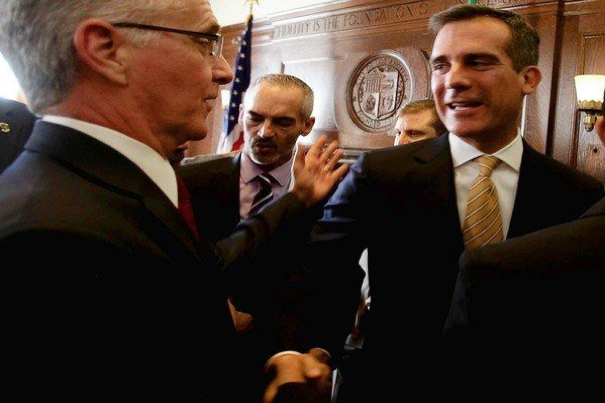CommentsLA WATCHDOG--On Tuesday, May 2, the 90-minute presentation, Back to Work to Fix LA, by the Coalition of LA City Unions to the Budget and Finance Committee of the Los Angeles City Council was not a discussion of the financial implications of achieving the goal of hiring 5,000 new civilian workers. Rather, it is a follow up to the goals delineated in the “historic” 2015-18 labor contract and an outline of union demands for the upcoming labor negotiations for the contract that expires on June 30, 2018.
While the goals of restoring public services, creating good jobs for Angelenos, and ensuring public safety are all laudable goals, how will the City be able to afford increasing the size of its civilian work force to 36,000 employees, the level before the City was hit by the Great Recession, from the current level of 31,000 workers?
The Four-Year Budget Outlook that was prepared by the City Administrative Officer is projecting a budget deficit of $104 million for the year that begins on June 30, 2018 and a cumulative four-year deficit of almost $300 million.
These shortfalls do not take into consideration an estimated $100 million increase in the annual required contribution to the City’s two pension plans associated with the lowering of the investment rate assumption to 7¼% from the overly optimistic rate of 7½%.
[The projected rate of return for the City’s two pension plans is 6.2%, the rate of return projected by CalPERS, the country’s largest pension plan. This implies that the annual required contributions based on the 7¼% assumption will short change the pension plans and result in an even greater unfunded pension liability.]
Nor does the Outlook account for any increase is salaries and benefits that will come from a new labor contract with the civilian unions. This will probably add $50 to $75 million a year to the deficit.
These extra cash expenses will increase the annual budget gap to $250 million in 2018-19 and the four-year cumulative deficit to almost $1.2 billion. And this does not include any salary increases for the Police Department.
The obvious conclusion is that the City cannot afford any raises to say nothing about expanding the size of its work force.
There has also been no discussion about the efficiency (or inefficiency) of the City’s work force. To the contrary, the civilian unions are trying to develop a monopoly over city services and contracts by making outsourcing even more difficult, even if independent contractors are more efficient.
But it seems as if City Hall has not gotten the message from former New York Governor Mario Cuomo who said, “It’s not government’s obligation to provide services, but to see that they are provided.”
This is not to say that you lay off City workers. But a little “managed competition” between city work crews and private contractors will give us a better understanding of how efficiently(or inefficiently) our money is being spent.
Despite the $1.2 billion increase in General Fund revenues, the spendthrifts that occupy City Hall have managed to perpetuate the Structural Deficit where the growth in labor costs exceeds the growth in tax revenues.
While it may be difficult, Mayor Eric Garcetti, the Paul Krekorian (photo above) led Budget and Finance Committee, and the rest of the members of the Herb Wesson City Council must develop the political will to say NO to the demands of the campaign funding union leaders.
We cannot afford any more budget busting contracts.
(Jack Humphreville writes LA Watchdog for CityWatch. He is the President of the DWP Advocacy Committee and is the Budget and DWP representative for the Greater Wilshire Neighborhood Council. He is a Neighborhood Council Budget Advocate. He can be reached at: [email protected].)
-cw
Sidebar
Our mission is to promote and facilitate civic engagement and neighborhood empowerment, and to hold area government and its politicians accountable.

 CityWatch Los Angeles
Politics. Perspective. Participation.
CityWatch Los Angeles
Politics. Perspective. Participation.
01
Thu, Jan














